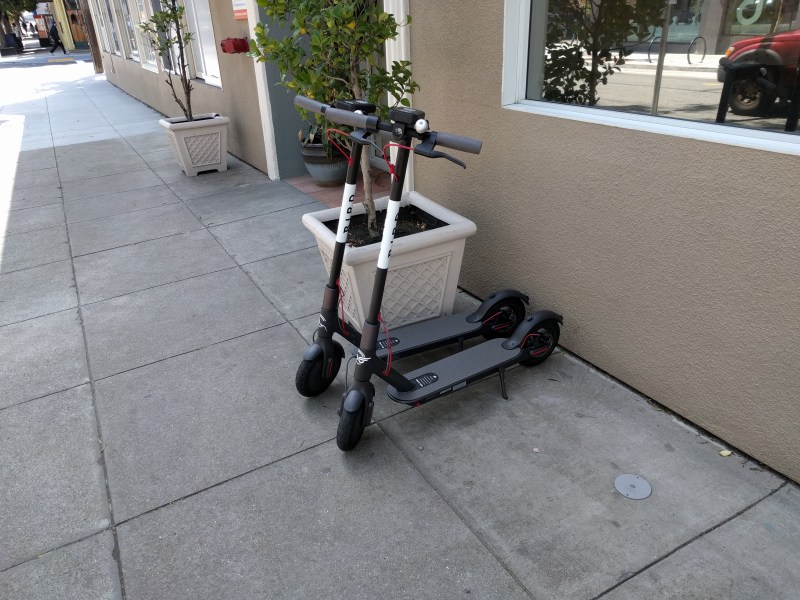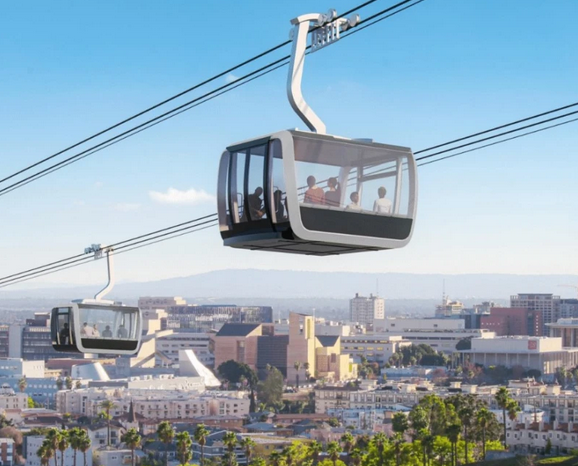Note: GJEL Accident Attorneys regularly sponsors coverage on Streetsblog San Francisco and Streetsblog California. Unless noted in the story, GJEL Accident Attorneys is not consulted for the content or editorial direction of the sponsored content.
After being amended in the Senate Transportation and Housing Committee last week, the e-scooter bill A.B. 2989 from Heath Flora (R-Ripon), has been reduced to a single change in the vehicle code: it removes the requirement for adult riders of stand-up scooters to wear helmets.
Bird, the bill's sponsor, had sought a clearer definition of what stand-up scooters are (including maximum speeds) and where they could be ridden (on sidewalks? in bike lanes?). But there was pushback from various quarters. Pedestrian advocates objected that the suggested top speed—25 mph—was too fast, especially if the scooters were to be allowed on sidewalks. Cities that are already dealing with e-scooters weighed in on different ends of the debate, with Santa Monica, for example—which has come up with its own e-scooter regulations—objecting on the grounds that a new definition would weaken current regulations and its own efforts.
Law enforcement agencies had objected that it was difficult to distinguish between various types of scooters, and thus would be hard to enforce new regulations based on power limits, which the bill originally intended to do.
There are already separate definitions for motorcycles, motor-driven cycles, and motorized bicycles or mopeds, as well as various classifications for e-bikes. A.B. 2989 tried to match the e-scooter definition to that of e-bikes—maximum speed 20 mph, no driver's license required, no helmet, with local regulations deciding whether sidewalk riding was allowed.
But that didn't fly. So now the bill avoids defining standup electric scooters as a new and separate thing. They remain included under the current definition of “motorized scooters,” which are designed for standing—but can have a seat; and are powered by an electric motor—or maybe some other motor, including human leg power.
Current law says riders of motorized scooters may not ride on sidewalks, may not carry passengers, may not go faster than 15 mph, and must have a driver's license—thus imposing a de facto age limit, so no one younger than 16 can legally ride them, which may come as a surprise to some current riders. Riders are also required to wear a helmet—the only thing A.B. 2989 would change.
According to various sources, the dockless e-scooter companies were concerned that a helmet requirement would kill their business. The companies recommend wearing a helmet while riding, and their apps and the scooters themselves remind riders that helmets are a wise idea. However, having a legal requirement is a different matter which could lead to targeted enforcement and fewer people riding these relatively environmentally-friendly modes of transport.
It's worth reminding everyone of this other section in the vehicle code, about electric powered scooters:
- This state has severe traffic congestion and air pollution problems, particularly in its cities, and finding ways to reduce these problems is of paramount importance.
- [Electric] scooters. . . produce no emissions and, therefore, do not contribute to increased air pollution or increase traffic congestion.
- It is the intent of the Legislature in adding this article to promote the use of alternative low-emission or no-emission transportation.
4/ We believe that the 20mph speed limit and increased permissiveness of sidewalk operation were a dangerous combo that would further undermine the safety of already inadequate and incomplete public RoW reserved for vulnerable sidewalk users. Those items led us to oppose 2989.
— CaliforniaWalks (@CaliforniaWalks) June 29, 2018
California Walks and L.A. Walks were unfairly blamed on Twitter earlier this week for their role in the bill amendments. CA Walks replied that it was a misunderstanding. “We believe e-scooters will have a role in fostering safe, healthy, inclusive streets,” they wrote, “but we could not support this bill because it did not prioritize the safety of our most vulnerable users. We did not advocate for the specific amendments that were announced this week.”
Their objections, as outlined in Streetsblog's article a few weeks ago, were specific to the combination of the proposed 20 mph speed limit and permissive sidewalk-riding—what they called “a dangerous combo that would further undermine the safety of already inadequate and incomplete public right of way reserved for vulnerable sidewalk users.”
The bill makes no changes to local regulatory authority in terms of registration or parking of e-scooters. The sponsors had hoped to create statewide consistency for ease of entering new markets, but for now it looks like local regulation – like recent ones in Los Angeles, Santa Monica, and San Francisco – will keep feeling their way towards a compromise.
A.B. 2989 hasn't passed the legislature yet—it is currently facing a vote on the Senate floor—so amendments are still theoretically possible.






